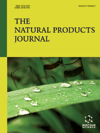- Home
- A-Z Publications
- Natural Products Journal, The
- Previous Issues
- Volume 14, Issue 9, 2024
Natural Products Journal, The - Volume 14, Issue 9, 2024
Volume 14, Issue 9, 2024
-
-
Terpenoid Components from Branches and Leaves of Aglaia lawii and their Biological Properties
More LessAuthors: Zhi-Xuan Li, Dan-Yu Huang, Yang Li, Yan-Ying Xian, Hao Zheng, Yun-Cai Tian, Yong Tian, Wen-Huan Zhang, Li-Gen Lin and Li-She GanIntroduction: Phytochemical investigation on the twigs and leaves of Aglaia lawii (Wight) C. J. Saldanha led to the isolation and characterization of sixteen compounds, including five sesquiterpenoids (1-5), one terpenoidal macrolide (6), seven phenolic compounds (7-13), two triterpenoids (14-15), and one steroid (16). Method: Their structures were identified by spectroscopic analyses and comparison with the literature data. Ei Read More
-
-
-
Marine Seaweed Polysaccharides: An Insight into Biological Activities and Biomedical Applications
More LessAuthors: Jegadeshwari B. and Saraswathy S.D.Natural products from various sources play a major role in the healthcare sector, mainly in the pharmaceutical, cosmetic, agro and medical divisions. Polysaccharides are one of the important biomacromolecules present in higher plants, animals, fungi and algae, and aid in the growth and development of an organism. They play a vital role in regulating and maintaining cellular homeostasis in all forms of life. They are consi Read More
-
-
-
Jaboticaba Peel Extract Exerts Chemopreventive Effects in Transgenic Mouse Model of Prostate Cancer
More LessIntroduction: Angiogenesis, oxidative stress, and epigenetic alterations involved in prostate cancer (PCa) are associated with different risk factors, such as a high-fat diet (HFD), overweight, and obesity. Jaboticaba peel extract (PJE) has shown antiproliferative, antiangiogenic, and antioxidant activities in the prostate of senile mice. Method: This study aimed to evaluate the effect of PJE on the dorsolateral prostate microenviron Read More
-
-
-
A Review on Nanocarrier-based Polyherbal Drug Delivery Systems for Wound Healing
More LessAuthors: Vaibhav Rastogi, Mayur Porwal and Athar AalamBackground: Nanotechnology-based polyherbal drug delivery systems are considered a new and rapidly emerging area in the pharmaceutical field. They improved the drug loading capacity or enhanced encapsulation efficiency of herbal drugs and thus improved permeation efficiency, accelerated wound healing, promoted tissue remodelling, and reduced scarring. Objective: A wound on the skin is an injury of the skin ti Read More
-
-
-
Antiphytopathogenic Diphenyl Ethers from the Marine-derived Fungus Aspergillus sydowii
More LessAuthors: Ying Shi, Xiao Yang, Jinwei Ren and Ling LiuBackground: Natural products from the marine-derived Aspergillus sp. have great potential in agricultural usage due to their broad biological activities. Objective: This study was designed to investigate the antiphytopathogenic compounds from marinederived fungus Aspergillus sydowii LW09. Methods: The compounds were isolated and purified by chromatography methods, and their structures were elucidated by analys Read More
-
-
-
Bioactive Constituents and the Molecular Mechanism of Melastoma dodecandrum Lour. in the Treatment of Inflammation Based on Network Pharmacology and Molecular Docking
More LessAuthors: Liu Shuang, Qiu Weiwen, Yin Qizhao, Zhao Meilu, Mei Mingrong, Lei Houxing and Zhang XiaoqinBackground: Melastoma dodecandrum Lour. (MD) is a component used in traditional Chinese medicine that is widely distributed in southern China. MD has long been used clinically to treat various diseases, such as inflammation. However, the potential anti-inflammatory mechanism of MD remains to be elucidated. Objective: In this study, network pharmacology and experimental validation have been used to explore the un Read More
-
-
-
Recent Advancements in Applications of Alginates in Drug Delivery, Tissue Engineering, and Biomedical Field
More LessAuthors: Saurabh Morparia and Vasanti SuvarnaAlginates, originating from the cell walls of brown algae, constitute a class of biopolymers known for their linear, unbranched architecture. Comprising both homopolymeric and heteropolymeric blocks, these polymers are constructed through glycosidic bonds linking β-D mannuronic acid and α-L-guluronic acid units in a 1-4 configuration. The specific arrangement of these monomers, whether in alternate, sequential, or ra Read More
-
Most Read This Month
Article
content/journals/npj
Journal
10
5
false
en


